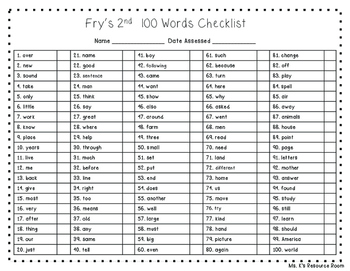
Words in English will not end in v, so words with ve at the end may be either short or long: Words with one vowel mushed to the schwa sound of uh (occurs especially often in words that begin with a or with the letter o followed by m, n, or v ):Īgain, about, around, away, what, from, come, some, done, love
FRY 100 SIGHT WORDS HOW TO
Here are some other commonly taught sight words and the rules and explanations for how to sound them out phonetically: The portion of this table below shows these same Dolch sight words arranged by their phonetic patterns. Note the separation of an and can across grade levels. Simple short vowel phonetically regular words are in blue. This chart below shows how sight words are normally taught in schools-alphabetically and split across grade levels. "This table contains words selected from the Dolch Basic Sight Vocabulary List which have configurational similarity and have the potential to contribute to the development of visual response patterning which is unreliable and confused." Laurita's article, Basic Sight Vocabulary - A Help or A Hindrance? Shown below is a portion of a table from Raymond E. Here are some of these 150 phonetic "sight words:" Findings suggest that using phonics instruction to remediate reading problems may be harder than using phonics at the earliest point to prevent reading difficulties.

For example, to improve their accuracy, students may need to suppress the habit of guessing words based on context and minimal letter cues, to slow down, and to examine spellings of words more fully when they read them. …when phonics instruction is introduced after students have already acquired some reading skill, it may be more difficult to step in and influence how they read, because it requires changing students' habits. Linnea Ehri in Systematic Phonics Instruction: Findings of the National Reading Panel talks about this problem as well: Many remedial students have developed guessing habits from too many sight words. Also, Don Potter has an excellent sight word web page explaining the harm that sight words can do. More videos are in aYouTube sight word playlist.
FRY 100 SIGHT WORDS MOVIE
To learn more about sight words, you can watch the sight word movie in QuickTime format or in YouTube format. įor further explanation of how sight words can encourage the symptoms of dyslexia and an explanation of the nature of sound and how our brains learn to process the sounds in words, see the dyslexia page. Sounding every word out from left to right helps encourage proper left to right eye movement while reading. Too many words taught as wholes by sight encourages the symptoms of dyslexia. Recent brain research has found that the adult brain of good readers does not process words as wholes, but instead, as Stanislas Dehaene explains in his article, The Massive Impact of Literacy on the Brain, by analyzing the individual letters and letter teams at the same time in a "massively parallel architecture." The speed of this parallel processing led early researchers to believe that the brain was processing the words as a whole, but recent brain research using more powerful technology has found the opposite.

For a good explanation of the nature and history of these sight words lists, see Comparing the Dolch and Fry High Frequency Word Lists by Readsters.

They should merely be taught phonetically along with other words.īoth the Fry and Dolch sight word lists are based on whole word methods and are high frequency words. Sight words should not be taught at all in a pure phonics program that teaches by sound. Of these 12 Fry sight words, 9 are completely phonetic and the other 3 have simple exceptions. The Fry 100 sight words or "instant words" are also commonly taught, and all but 12 of them are contained on the Dolch list.

For the other 70 words, 68 conform to simple patterns of exceptions and can be taught phonetically. Of the 220 most commonly taught Dolch sight words, 150 are completely phonetic and can be easily learned by sound. However, many of the newer phonics programs also use an alarming number of sight words. This can cause problems for many students. Whole word methods teach every word as a sight word, one word at a time, without teaching students the sounds in these words.


 0 kommentar(er)
0 kommentar(er)
